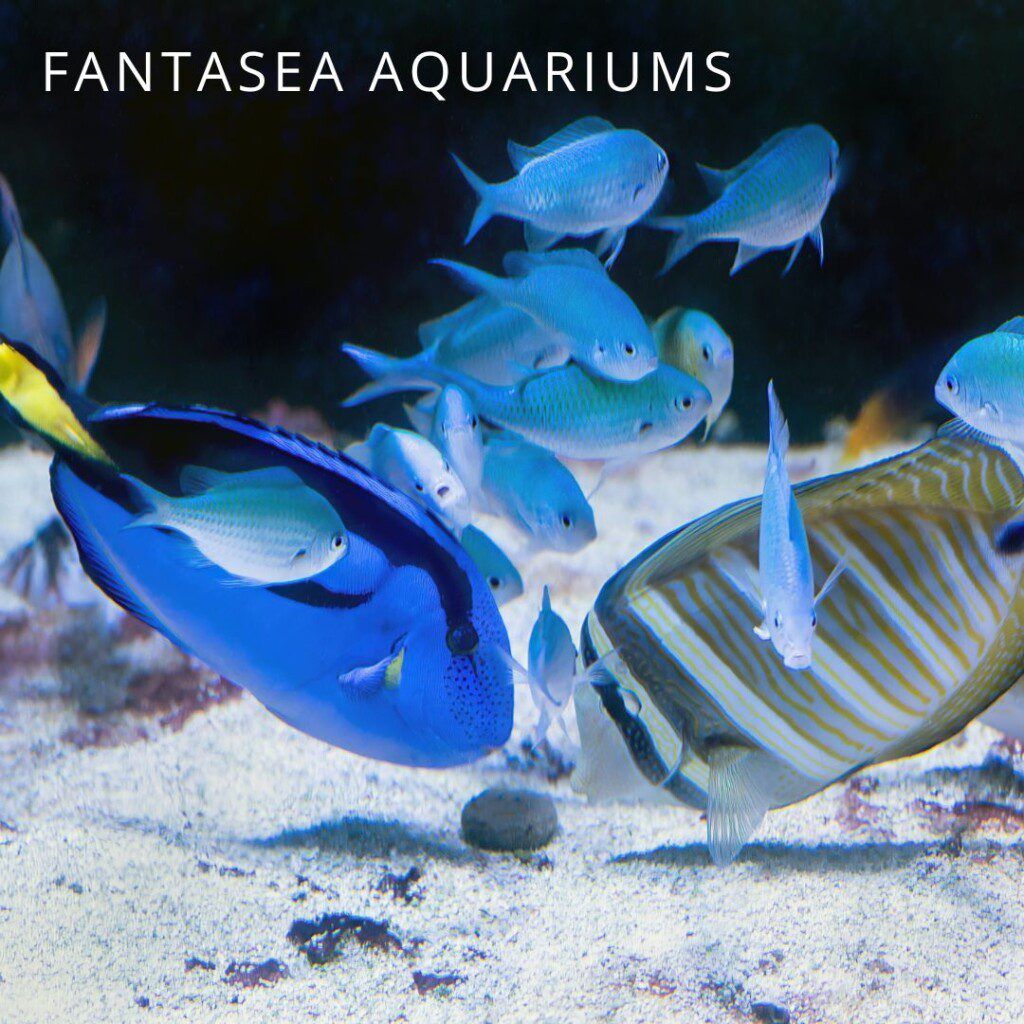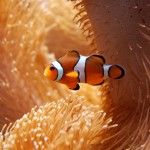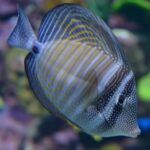Just set up your first aquarium and stocked it with all the beautiful fish you were dreaming of keeping, but now wondering how much to feed? Welcome to an issue every beginning aquarist runs into! It can be difficult to figure out how much food your fish need and how often to feed them.
Instructions on fish food packaging aren’t always accurate – they want you to use as much of their product as possible – and the fish themselves aren’t much help either, as they’re always begging for more. How do you prevent them from becoming obese or starving?
We can help. Let’s have a look at everything you need to know about feeding fish. You’ll learn to estimate quantities, frequency and everything else you need to know to keep your aquarium healthy and your fish well-fed!
Can you overfeed a fish?
In case you were wondering: yes, you can absolutely overfeed a fish. In fact, it’s easier than you’d think! For starters, some fish food containers state to feed your fish as much as they can eat in as many as 10 minutes. That’s way, way too much. Keep in mind that fish don’t know when to stop, and they’ll almost always keep eating for as long as the food keeps coming. If you keep it coming for ten full minutes, they will be on the brink of exploding by the end of it.
It doesn’t help that, as mentioned in the intro, fish will always beg for more. Many will quickly learn that your presence is somehow related to food appearing. As a result, they’ll dance excitedly at the front aquarium pane every time you walk past, even if you’ve already fed them. It’s easy to fall into the trap of thinking they might be hungry and in need of more food. They’re not, they just don’t know any better!
Fish can actually become obese. This leads to health issues and a shorter lifespan, for example due to fatty liver disease. This is something we see often in Betta fish, as they’re generally kept alone (so no competition for food) and are excellent at appearing hungry.
Overfeeding & water quality
However, fat fish aren’t the only problem that can pop up as a result of overfeeding. More significant – and more pressing – is water quality. If you feed more than your fish can eat, food will almost always end up sinking to the bottom of the tank unseen. Here, it’ll decay, which can be a disaster for your aquarium’s nitrogen cycle!
Best case scenario, nitrates will soar, which is not great for fish health in the long run. Worst case scenario, nitrates and ammonia levels will shoot up, which can actually temporarily turn the tank into a toxic environment. Fish deaths are not unheard of during these spikes.
Of course, there are things you can do to limit the damage. A little cleaning crew consisting of shrimp and other bottom feeders can help take care of any leftover food quite efficiently. However, as any aquarist who keeps fish that need to be fed a lot or are messy eaters (like baby discus fish, pufferfish) will tell you: it’s just way harder to keep the water quality in a heavily fed aquarium under control.
Especially for beginners, then, it’s a good idea to keep an eye on the amount you feed. Fish don’t need as much food as we tend to think, and although they may like to pretend they’re starving every time you walk by your tank, their health will thank you in the long run if you take it easy.
How much and how often should you feed your fish?
How much?
Okay, so we’ve established it’s definitely possible to overfeed a fish. We’ve also established that it’s a bad idea to do so. The “as much as they can eat in 10 minutes” rule of thumb is wrong. But how much food should you give them, then?
One great rule of thumb that’s common in the aquarium hobby is that the stomach of a fish is around the same size as its eye. Now, whether this is actually scientifically correct is debatable, but it does actually make for a great guideline to follow while feeding.
Remembering the eye rule, it becomes easy to see that each fish only needs a few flakes or pellets per feeding. Returning to Betta fish, you’ll notice that although most of us instinctively want to give them a good pinch of those mini pellets, limiting mealtimes to 2-3 pellets at a time is a better idea.
If you do want to use a time-based rule of thumb, this does work as well, you just need to think smaller. Rather than giving your fish as much at they can consume in 10 minutes, maybe it’s best to make that 2-3 minutes instead. Keep an eye on their bellies: if they start looking nice and round, you can stop. This can be quite obvious in some species, like pufferfish.
Tip: Many aquarists recommend including one fasting day each week to make up for any overfeeding. This is not a must, but the fish will be fine in any case, and we’ve used this technique on plenty of aquariums throughout the years.
How often?
Now that you know that aquarium fish don’t need as much food per meal as we tend to think, let’s go into feeding frequency. When considering how often to feed your fish, it’s important to remember that in the wild, many species will tend to come across edible morsels throughout the day (or night, if they’re nocturnal).
As such, in the aquarium, it’s often not the most natural or healthy thing to give them one big meal daily. Instead, if possible, it’s better to go for multiple smaller daily feedings with most species. This especially applies to grazing (mostly) herbivorous species like saltwater tangs or freshwater goldfish, which would naturally nibble on algae for much of the day. Their systems aren’t adapted to receiving large portions infrequently.
Large predatory fish constitute an exception to this rule. Take moray eels, for example: they only need to be fed once or twice a week. If you feed them more, they will often take the food, but then spit it out again later and create a big mess.
In summary, for most fish, feeding between 1-3 times a day works fine. You should reduce portion sizes if you plan on feeding more frequently on a given day. However, it’s important to look up the individual needs of each species you’re interested in keeping to make sure you give them what they need.
To make this a little easier, let’s have a look at how often you should generally feed a few popular aquarium fish. Remember that there should ideally be around 6 hours between each feeding:
Freshwater fish
- Betta fish: 1-3 times a day
- Goldfish: 2-4 times a day
- Angelfish: 2-3 times a day
- Pufferfish: 2-3 times a day
- Tetras & other small schooling fish: 1-2 times a day
- Most cichlids: 2-3 times a day
- Corydoras: 1-2 times a day
- Pleco catfish: 1 time a day
- Livebearers: 1-2 timea a day
Saltwater fish
- Clownfish: 1-2 times a day
- Wrasses: 2-4 times a day
- Tangs: as many small portions as possible. Give them seaweed to graze on.
- Moray eels: 1-2 times a week
- Blennies: need constant supply of algae + feedings once or so a day.
- Gobies: 2-3 times a day
- Angelfish: 2-3 times a day
- Pufferfish: 2-3 times a day
- Damselfish: 1-2 times a day
Most invertebrates, like snails, shrimp and crabs, will at least partially live off any food your fish missed. Some will also consume algae or biofilm that naturally grows in the aquarium. Still, you can drop in some sinking food like an algae tablet a few times a week to make sure they’re well-fed.
Remember: you should always remove any uneaten food bits from the aquarium within a few hours. This really helps keep water quality under control.
Tip: As briefly mentioned, some aquarium fish species are nocturnal. Be sure to plan at least one feeding for right before you turn off the lights for the night if you keep any of these. Otherwise, they may end up missing out.

How long can a fish go without food?
Going away for a few days? You may be surprised to learn that, as long as you don’t go away for very long, a fish sitter won’t always be needed. Although juvenile fish don’t have the fat stores required to go for more than a day or two without food without the risk of their growth process being impacted, it’s different for adults.
We once spoke to a Betta fish breeder who would leave his fish for up to 2 weeks without food to go on holiday and would find them all alive when he got back. They didn’t even tend to get all too skinny!
Although 2 weeks is definitely cutting it close, you can leave healthy and well-fed fish for at least a week with no issues. Skipping the fish sitter, or at least the feedings, comes with the added advantage of better water quality while you’re away. Fish that aren’t eating won’t produce nearly as much waste, meaning no water changes needed and lower chances of issues arising while you’re gone.
If you’re planning on being away for longer, you can have someone come in every few days to feed the fish. However, keep in mind that at some point a water change will be required. It’s a good idea to pre-portion feedings, because as we’ve discuss, folks tend to overestimate how much fish eat. Every long-time aquarist has heard horror stories of someone’s fish dying because the sitter threw half a container of food into the tank!
Recognizing an obese or underweight fish
As with all pets, it’s a good idea to keep an eye on the weight of your fish. After all, if they’re looking strangely skinny or overly fat, that can be an indication that something is wrong. It may point to issues with your feeding schedule, but can also be the result of something like an illness.
An systematically overfed fish can be a little difficult to spot, especially because diseases like dropsy or bloat will also manifest in the form of a round and fat belly. In any case, an obese fish eventually becomes quite rotund. Its belly will be evenly round even hours after feeding time, and its entire body will just be a bit more girthy than in “normal” members of its species. This thread on Humble.Fish has some good examples!
A skinny fish, whether as a result of disease or underfeeding, is easier to recognize. They can start to look quite sunken in, especially right behind the head. The belly will be flat or even caved in rather than plump and round, and in extreme cases, you can begin to see some bones.
If your fish is or are looking skinny, you need to rule out parasites first. How long ago did you get them? Are they eating well? Is it one fish that looks underweight, or multiple? It’s not uncommon for fish to have worms, so do some diagnostics instead of upping the feedings immediately.
What should you feed your fish?
Although the topic of all the different fish food options out there is much too wide to go into in detail here, we do want to pay some attention to it. It’s important to remember that not all fish foods, nor all fish, are made equal.
There are loads of different types of fish food out there of varying quality. Some brands are packed with low-quality fillers, while others take care to produce a product that will actually benefit your fish. Do some comparing!
You should also do a little research into what the fish species you keep like to eat. Although many are omnivores that can survive on any generic food, others have evolved to require more specific meals. Think of pufferfish, whose teeth overgrow if they can’t chomp on hard foods like snails and molluscs. Or tangs, which need plenty of seaweed and algae to keep their systems working properly.
A few fish food options to consider include:
- Pellets (in all sizes)
- Flakes
- Frozen food (like bugs and small meaty bits)
- Sinking wafers
- Live food (learn more about different types of live food)
- Freeze-dried food
- Gel food
- Natural food (fresh veg, seafood, seaweed sheets and more)
Conclusion
Is this all sounding like a little much for you? We understand, which is exactly why FantaSEA Aquariums is here to take care of our clients’ aquariums. If you want all the fun of fishkeeping but none of the hassle, let us take over maintaining (or designing, or building…) your tank for you. Just contact us with your ideas!






